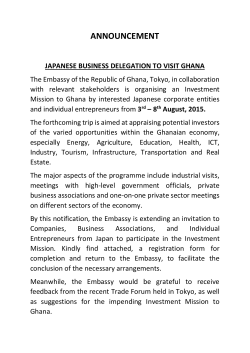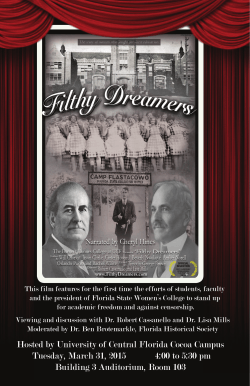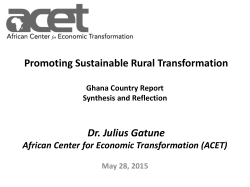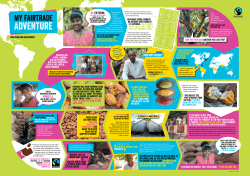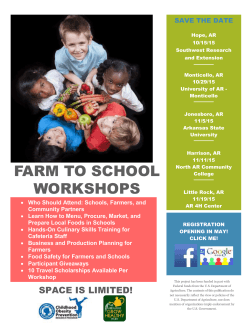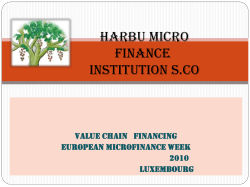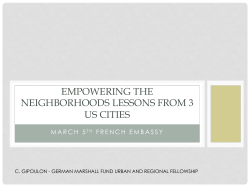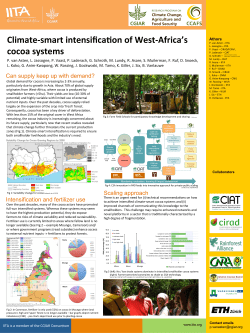
- INCLUDE Platform
Multi-stakeholder Workshop For Knowledge Sharing Theme: Partnership arrangements as strategic action for inclusive development: Practice and Outcome NMIMR, University of Ghana, Legon, 11th March 2015 Present: The 47 participants of this workshop include policy institutions such as the Ministry of Agriculture and CSIR, private sector, International Organisations, Farmer Based Organisation (FBOs), Non-Government Organisations (NGOs) and actors connected with the partnership arrangements. Introduction Partnership arrangements are increasingly seen as a promising approach to mobilise strategic actors for economic growth and inclusive development in the agricultural sector in Ghana. Partnership practitioners see the value of partnership arrangements in spite of the fact that integration in the overall governance structure remains a challenge. There is limited knowledge on the functioning and outcomes of partnership arrangements in various agricultural value chain contexts. Against this background, a research project has started with collaboration between Wageningen University and University of Ghana. The research involving practitionerknowledge-sharing therefore aims to generate in-depth evidence and joint understanding of (a) the conditions for strategic actors to initiate or get involved in partnerships for inclusive development, and the institutional entrepreneurial mechanism that partnership members employ to create this development; (b) the induced institutional bricolage leading to new forms of innovation governance; and (c) the impact in terms of economic practices and relationships between smallholders and other value chain actors. A preparatory workshop held in February 2014 identified the following partnerships in Ghana: 1. Local-level partnerships: Funded by agricultural donors like IFAD, FAO and FARA/CORAF, AusAID, researchers of the CSIR-CRI and the MOFA initiate local innovation platforms in the Transition and Savannah zones, focusing on improved agricultural productivity, food processing and marketing. 2. COS-SIS partnerships: Funded by DGIS, the COS-SIS programme initiated a national level innovation platform in the cocoa sector and a regional/national platform in the palm oil sector of Ghana. Platform sought to create institutional change for the benefit of smallholders. 3. Public-private partnerships: Private actors and NGO’s such as fair trade organization Solidaridad and IFDC initiated Public-Private-Partnerships (PPP) for smallholder development in the domain of cocoa, palm oil, soy beans, fruits and vegetables. 1 The main concerns of the participants at that workshop were on issues of governance and sustainability. In other words: what are suitable and sustainable collaboration initiatives and structures to engage smallholders and other chain actors in the development of their value chains? Research Project Objectives To gain insight in this, the current project seeks to analyze and compare the conditions, actions and outcomes of partnerships: How, and to what extent do they mobilize strategic actors and attain inclusive development? And what is the outcome, in terms of innovation governance structure and the economic position of smallholders? For this analysis, the project will use the concepts of partnership structure, institutional entrepreneurship, institutional bricolage and institutional economics. As part of the project implementation two post-doctoral researchers: one with a background in social and political science/Innovation systems and one from Institutional Economics are undertaking exploratory studies on partnership arrangements in agricultural value chains. Purpose of this Workshop This first multi-stakeholder workshop is a kick-off knowledge sharing workshop that launches the project. It will also bring together various stakeholders and provide the opportunity for partnership actors to share their partnership stories. They will also jointly look at the different phases of the partnership-innovation process from the angle of the project, analysing (1) the partnership composition (2) the partnership internal functioning and (3) the partnership action for change (institutional entrepreneurship, . Workshop process The workshop began with the introduction of the Chairman for the occasion Prof. Samuel K. Offei, Pro-VC Academic and Student's Affair, University of Ghana, by Dr. George Essegbey, Director CSIR-STEPRI. This was followed by a response from the Chairman and a welcome statement from the Project Coordinator Dr.ir. Annemarie van Paassen. There were presentations from researchers from Solidaridad, Donata and CoS-SIS followed by group discussions on the various presentations. Chairman's remarks In his remarks, Prof. Samuel K. Offei indicated that, the aim of the workshop was to share ideas on the partnership arrangements. A question was on the governance structure of the partnerships and how these were undertaken? He added that in CoS-SIS, there were various partnerships at various levels with e.g., farmers, Universities, Government Institutions, and various stakeholders. Other questions according to him to be answered included how the benefits were to be derived from these partnerships and their arrangements? Do these partnerships disintegrate after the project was completed? He stressed that, at the end of the workshop answers to these questions will be obtained. 2 Welcome statement by the Project Coordinator In her statement, Dr. Annemarie van Paassen stressed that the current project was inspired by previous experience with CoS-SIS innovation platforms. According to her, the study of partnerships was important so that at the end of a project the roles and benefits of these partnerships could be derived. Three groups (Solidaridad, Donata, and CoS-SIS) would present the story of their partnership process so that the participants could make a first analysis of (a) the partnership composition/structure, (b) the feature of their internal partnership functioning, and (c) the partnership action and institutional impact (institutional entrepreneurship). Dr. van Paassen mentioned that an area of concern highlighted in the preliminary workshop was sustainability of these partnerships and governance issue. How do the value chain innovations work in an effective and sustainable manner for inclusive development? These were questions to which answers were needed. There are currently two Post-Doctoral Researchers, Dr. Charity Osei-Amponsah and Dr. Alexander Nuer working on partnership arrangements in two domains. At the end of the program they will provide answers to some of these questions. Seminar Presentations (Story Telling) Presentations were made by 3 groups (Solidaridad-Mr. Eric Amoako Agyare, Donata-Dr. Grace Bolfrey-Arku and CoS-SIS-Dr. Richard Adu-Acheampong). 3 A) FIRST STORY TELLING BY MR. ERIC AMOAKO AGYARE- SOLIDARIDAD The overview of his presentation had the following features: CORIP Key Features Implementation strategy CORIP Conceptual Framework The Story CORIP key features included the following: 4 - year programme (2013 – 2017) Implemented by consortium of partners (Cocoa companies, IFDC, COCOBOD, EKN, IDH, Solidaridad West Africa (SWA) & coordinated by SWA Funded by Dutch Embassy, with co-funding from private sector cocoa partners, IDH Grant budget; plus other matching contributions from Focus on learning and innovations development CORIP implementation strategy also involved the following: Set up and run cocoa Rural Service Centres (RSC) as vehicles for service delivery RSCs established and managed by private companies Work towards financial viability/sustainability of RSC Core technical & coordination support provided SWA/IFDC/CRIG) Additional technical assistance services provided through other private sector service providers RSCs organise demand for and supply services PLANTING MATERIAL AGROCHEMICAL INPUTS TRAINING OF FARMERS/GROUPS FINANCIAL SERVICES PROVIDING SERVICES OTHER COMMUNITY DEVELOPMENT SERVICES INCOME STREAM/ COST STRUCTURE RURAL SERVICE CENTERS CROP BUYING SERVICES OTHER COMMUNITY DEVELOPMENT SERVICES ECONOMIC VIABILITY ADDING VALUE TO FARMERS FARMER GROUPS YOUTH 5 Fig 1. Conceptual framework 4 THE STORY Comps & inds s’holders discuss sust options to enhance sector competiveness Embassy hires Advance consulting to support MASP Embassy looking for opportuniti es for dev’t supp Cocoa comps involved in sustainability initiatives Contribution agreement signed b/n SWA/Embassy Series of mtgs between comps/NGOs/ Cocobod Embassy draft steering note to support cocoa sector 2011 Market demand for sust, supply of cocoa beans Prog off set up & logistics Embassy interest in cocoa; Mission to Ghana Cocoa comps involved in sustainability initiatives 2014 2013 2012 SWA/IFDC/ Cocobod/ comps discuss productivity improve’t initiatives Press ceremony at Embassy MOU signed among partners Series of mtgs between comps/NGOs/ Cocobod/ Embassy PAG formed Series of mtgs between comps/NGOs/ Cocobod/ Embassy Prep. of prog gov & Imp manual Inception meeting of partners to discuss way forward THE STORY, CONT’D 6 Signed subagreement with GRIG, April Inaugurate TSSC, April Signed subagreement with IFDC, Feb 2nd Signing of comp sub agreements, Aug-Oct Sign agmt with IDH, April Approval of grant proposals, Apr & May Technical site visits to RSC locations, Aug-Sept Set up of nurseries, demos etc begins, Oct - call for proposals, Dec PAG meeting, Dec MELI disc begin with UoG, IDH, WUR Aug 2014 Monitoring visits, Cap Dev of RSCs ongoing Receive EOI from interested comps 2015 Submission of comp proposals, Mar Approval of Prog Impl Manual, Mar Official launch of CORIP, June Provision of grant award letters, June 1st grant disbursements, Sept-Nov Capacity dev for RSC staff, begins Consortiu m meeting, Dec Monitoring visits RSC set up commence, Sept Fig. 2. The story Evaluating company proposals Baseline dev commences 7 5 B) SECOND STORY TELLING BY DR. GRACE BOLFREY-ARKU Experiences from DONATA Ghana: Cassava Innovation Platforms, Wenchi Municipality Focus of Ghana DONATA IP: Improve income of smallholder cassava producers, processors, marketers and other stakeholders along cassava chain. Objectives: - transfer and disseminate improved technologies to farmers along the cassava chain i.e. production to marketing Exchange and share indigenous knowledge and practices among various stakeholders Foster strong collaboration and trust among stakeholders Enhance skills and knowledge Initiation of DONATA National launching of DONATA Project - June 2011 In attendance partners of Agric R&D Presentations and Discussions • Focus and objectives of DONATA, Ghana • IP systems • Existing technology transfer and dissemination systems • Ensuring the sustainability of the IP after the exit of DONATA. • Challenges to be encountered in the implementation • Roles of major institutional stakeholders on the platforms Setting up of IP - Determination of Entry Points PRA • all relevant beneficiaries, target groups, and stakeholders. • identify challenges/constraints and needs • Analysis of the problems and needs Prioritization of constraints Defining entry points by consensus – ensure it can be addressed in project life span. Determination of thematic area Ensure proposed interventions answer “real felt needs”. PRA Baseline Information 2011 for DONATA Communities • • • • • • Heavy reliance of farmers on local variety with yield range of 5-9 t/ha 2 known improved varieties – Bankyehemaa and IFAD yielding 12 to 16 t/ha. Maximum net profit is about $80.00/ha. Improper or inadequate weed and soil fertility management Weak or non-existence formal linkages among stakeholders Information sharing was weak among major stakeholders. 6 Experience has shown that most farmers expected monetary reward for taking part in project activities, thus the objectives of the DONATA IP was fully explained and discussed. Hence actors along the chain were selected based on willingness to participate. Determination of Entry Points & Establishment of IP 1. Producer access to improved cassava varieties and enhanced soil fertility management 2. Use of herbicides to control perennial weeds in cassava 3. Cassava product development and market access. Five IPs defined by community name established based on above entry points - consensus Setting up IP – Stakeholder Analysis Research Local Assembly Producers Local artisans Retailers 1Local & 1 regional radio Traditional leader NGO Agri-input dealers Transporters WIAD Extension Business Advisory centre Processors EPA Wenchi Rural Bank Process and Product Innovations 2011 : 3 IPs with 30 actors; We considered our limited experience on IP management, also fact concept is new to all stakeholders and resources available, all guided by past experience 2012: 4 IPs, 100 actors 2014: 5 IPs, Better understanding IP Concept after workshop and field visits for facilitators of DONATA in sub region by CORAF Challenges • Knowledge Gap: Limited knowledge on IP process • M& E: Effective integration on Platform activities • Data Collection: tendency to present or report qualitatively • Perception: Changing mindset of research & extension facilitators and other actors • Influencing policy: issues eg use of weighing scale • Risks: Getting buy in on private partnership to promote entrepreneurship • Sustainability: Funding the IP and sustaining • Governance structures - Municipal, Regional and National Immediate Outcome from Platforms • Farmers through sensitization appreciated importance of quantitative data in assessing performance of their activities. • Enhanced interactions and participation through Farmer –led field visits/tours, Peer learning and Mentoring. • Regular interactions among various actors promoting trust. 7 • • • • • • Brokers: Marketing challenges of Nkonsia IP resolved through a transporter who realized a market opportunity as well. Purchase of used motorbike by a platform member from Nkonsia Constant sensitization on sustainability encouraged Ayigbe Platform to contribute $1250.00 towards the construction of Good Processing Centre (GPC). Resource mobilization by IP actors from constant Sensitization has encouraged buy in of IAR4D concept by policy makers thus one way of technology dissemination by WAAPP Emerging 2014 Municipal best cassava farmer from Wenchi IP. Championing: An actor converged all 5 IP for a joint proposal to COVET for skills training to enhance quality. First stage passed & now in 2ndphase of processing. Achievements • Direct beneficiaries of 33 actors (22 M, 11 F) in 4 platforms from inception to 201 (86 M, 115 F) in 5 platforms and 131 indirect beneficiaries. • Access to 6 other improved varieties (Ampong, Agbelefia, Dokuduade, Esambankye, Sika and Otuhia), besides the 3 (Afisiafi, Bankyehemaa and IFAD) that existed prior. • 70% increase in use of herbicide nozzle. • Glyphosate application rate reduced by 60% (10 L/ha to 4 L/ha) • Row planting increased population by 47% • Root yield increased from 12 -16 t/ha to 42 t/ha Business Enterprise: • Ayigbe IP GPC completed for launching; contribution of $1250 (kind and cash) by Ayigbe IP actors towards GPC to encourage ownership. • 2 commercial grower/processors linked to 30 producers • Local chiefs and queen mothers motivated to be part of Amponsakrom, Nkonsiaand Wurompo IPs and have release land for establishment of GPC. • 8 C) THIRD STORY TELLING BY DR. RICHARD ADU-ACHEAMPONG Title: Innovation platform for institutional change: the case for cocoa in Ghana Importance of cocoa to Ghana: 1. Foreign exchange earner 2. Major source of income for some 800,000 smallholder farm-families Ghana has reputation for producing high quality cocoa beans, but a number of key institutional constraints cause low productivity, profitability and lack of sustainable livelihoods. Innovation in the context of improving livelihood • A new way of thinking with implications for the cocoa sector : for livelihood development and poverty reduction • An innovation platform termed ‘concertation and innovation group’ (CIG) was created with the objective of working towards removing institutional constraints facing small-scale cocoa farmers. Stakeholder Identification Stakeholder Analysis Establishment of the CIG Fig. 3. Stakeholder-Actor Identification Cocoa Supply Chain Map Cocoa Marketing Company Exporting Processing Quality Control Company Ltd Transport Bulking/Quality Control/Warehousing Production Quality Control Company Ltd Processors Haulage Cocoa Marketing Company COCOBOD Licensed Buying Company Cocoa Farmers Quality Control Company Ltd Input Suppliers 7 Fig. 4. Map of cocoa supply chain 9 Constraints addressed by the IP • Incentives for cocoa quality at producer level • Policies of subsidized input distribution • Incentives for private sector input supply and support services, and inappropriate use of agro-chemicals Entry point Pricing and price incentives for farmers Activities Joint experimentation on pricing policy and price incentives for cocoa farmers High level institutional issues System Innovation Institutional changes in price incentives CIGs/RA PhD Establishing equitable distribution of farming inputs Building network among actors Expected outcome Improved income for farmers PhD Thesis Research with farmers at local level Supervisors Fig. 5. Entry points and expected outcomes of CIG/RA/ PhD student interactions Facilitation • Identification and prioritization of institutional and technical onstraints/opportunities for innovation • Facilitate the activities of the Concertation and Innovation Group (CIG) and promote interactions among the members • Facilitate the identification and validation of alternative institutional experimentation that addresses identified constraints The CIG in Action • Working on pricing policy (composition of price structures – f.o.b. & price paid to farmers and pricing in neighbouring countries). Free/subsidized input supply, support services: more transparency input distribution in the newspapers Fig. 6. Higher producer price for farmers in 2010 10 Group work After each story, 3 Work groups analyzed the story on a) Partnership structure/composition: • Who initiated the partnership, motivated/focussing on what issue? • Which type of actors participate and who not? (NGOs, policy-makers, value chain actors, etc.) • Which type of resources are they bringing in? And what lacks? (a) authority/legitimacy to decide/control (b) knowledge/skills (c) human and material resources (including money) b) Partnership features (internal functioning) • Level of sharing: How much do they share (a) authority, legitimacy, decision making, (b) knowledge/information; (c) investment of resources for implementation • Formalization: Do the use informal/face-to-face personal or more formal arrangements for collaboration and action? • Type of coordination elements: (a) Are there democratic (collegial) or hierarchical procedures in place? (b) What type of incentives do (organisational) actors have to participate/contribute to the partnership? c) Partnership actions (Institutional Entrepreneurship) • Using legitimate authority to change ‘the rules of the game’ • Education/training and technical development to improve the performance capacity of value chain actors • Resource/Asset focussed actions • Type of impacts / effects 11 Plenary-Comparison of cases, with extra reflection on inclusiness and sustainability aspects In the end there was a comparative analysis of the composition, internal functioning and actions of the various types of partnership, after which a plenary reflection was launched on the critical issue of inclusiveness and sustainability. The following challenges were identified: 1st story telling CORIP cocoa case Service providing system should be sustainable The beneficiaries of an intervention should be included in the planning stages of any partnership Apart from input costs, other related costs should be taken into consideration e.g., post-harvest losses Taboos and how they are incorporated into interventions must also be noted. 2nd story telling DONATYA Cassave case In managing interests of broad-based partners to achieve the goal of inclusiveness, specific stakeholders must be brought in when their roles are needed. Facilitators should be chosen based on the experience they possess e.g., managerial skills. 3rd story telling CoS SIS cocoa case Bringing diverse types of actors, including farmer representatives, together to be part of an innovation system is highly encouraged. Sustainability concerns stimulated CoS SIS researchers-cum-facilitators to present the approach to other research institutes and develop a curriculum for graduate students. In this way many professionals will be sensitized on the value of multi-actor innovation platforms for overcoming institutional constrains for smallholder development in various agricultural sectors. Closing remarks by the International Coordinator Dr. Annemarie van Paassen thanked all participants for their commitment and critical contributions throughout the workshop. She hoped the workshop had provided the participants with an idea of the type of analysis and reflection the NWO program aimed for. She further thanked the national coordinator and workshop leader Dr. George Essegbey, the consortium members and the other support staff for their help in making the workshop successful. 12
© Copyright 2025
